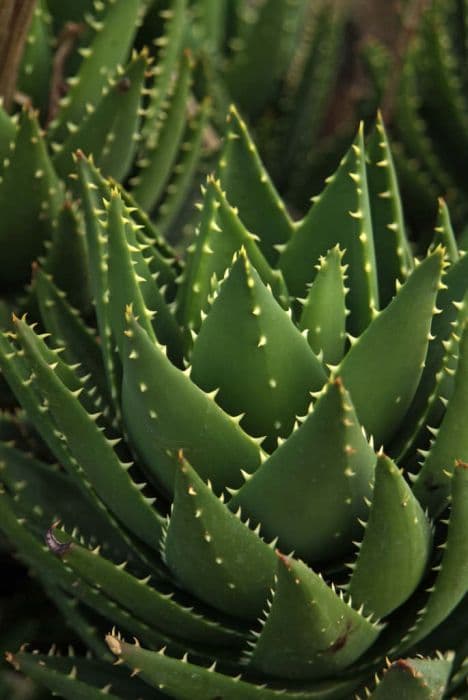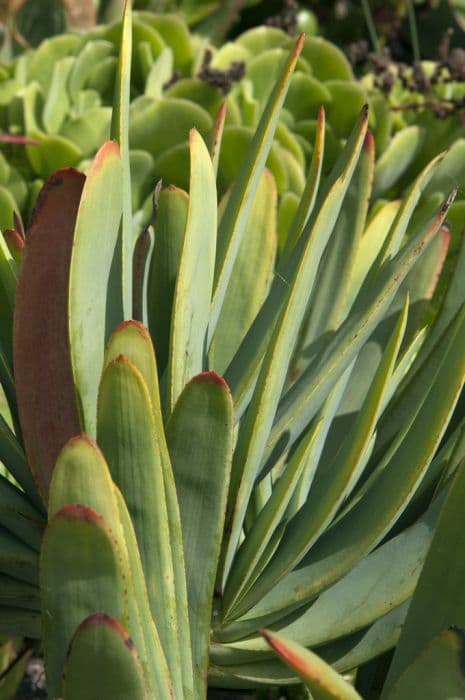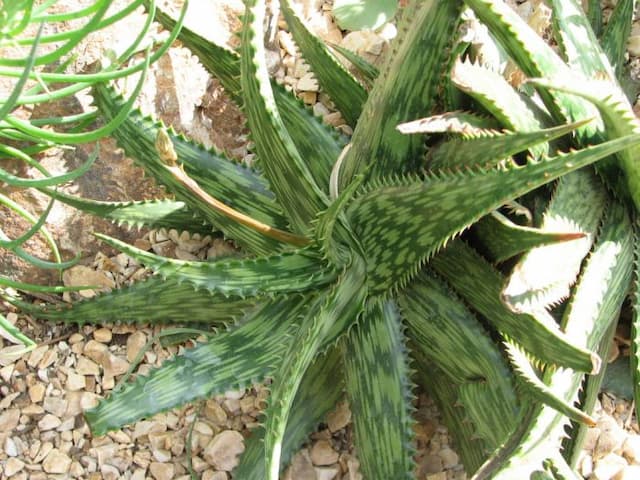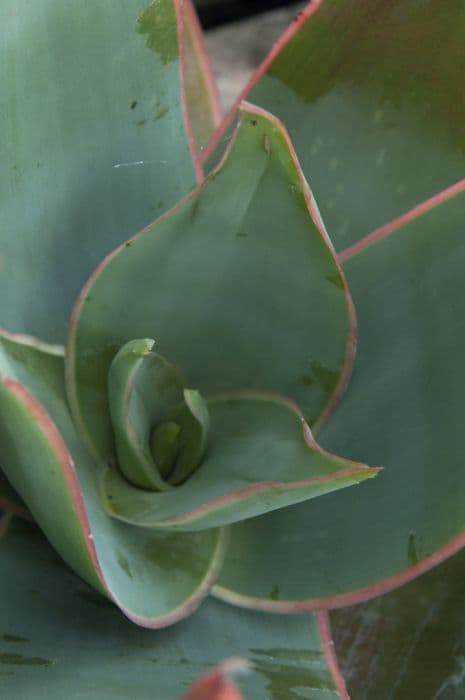Foxtail Lily Eremurus 'Joanna'

ABOUT
Eremurus 'Joanna' is an ornamental plant known for its striking floral spikes and is commonly referred to as the foxtail lily or desert candle. The appearance of this plant is characterized by its long, towering spires adorned with star-shaped flowers which are densely packed along the stalk. The blooms can be found in a range of colors, with 'Joanna' showcasing a beautiful soft pastel or warm apricot hue. The plant emanates a graceful and stately presence in the garden. The foliage of the foxtail lily consists of a basal rosette of long, slender leaves that are strap-like in shape. These leaves may have a slight arch to them, fanning out around the base of the plant, creating a lush green platform from which the central flower spike emerges. As the blooming season progresses, these leaves typically wither away, drawing more attention to the spectacular flower stalk that dominates the plant’s visual display. As the main attraction, the flower spike is adorned with numerous tiny blossoms that open progressively from the bottom upward, prolonging the bloom period of the plant and providing an ever-changing aspect to its appearance. The individual flowers making up the flower spike are delicate and often have a soft, subtly ruffled texture, contributing to the plant's overall ethereal and elegant impression. After flowering, the plant produces seed pods which add another dimension of visual interest. The foxtail lily is particularly striking when planted in groups or clusters, where the full effect of their vertical accent can be appreciated in the landscape. It is a plant that is often used to add structure and height to garden designs without the specifics of its dimensions.
About this plant
 Names
NamesFamily
Asphodelaceae
Synonyms
Foxtail Lily, Desert Candle
Common names
Eremurus 'Joanna'.
 Toxicity
ToxicityTo humans
The Eremurus 'Joanna', commonly known as Foxtail Lily, is not typically recognized as a poisonous plant to humans. There is limited information available about its toxicity, suggesting that it is not generally hazardous if touched or ingested in small quantities. However, as a precautionary principle, it is advised not to consume any plant part without proper knowledge or confirmation of its edibility, as individual sensitivities or allergic reactions could occur.
To pets
The Eremurus 'Joanna', known as Foxtail Lily in its most common form, is not widely known to be toxic to pets either. While there is a lack of specific information regarding its toxicity to animals, it is not commonly listed among plants that pose a threat to pets' health. Nonetheless, pet owners should exercise caution and prevent pets from ingesting plants that are not confirmed to be safe, as animals might have individual reactions or sensitivities to plant materials.
 Characteristics
CharacteristicsLife cycle
Perennials
Foliage type
Deciduous
Color of leaves
Green
Flower color
Peach
Height
5 feet (1.5 meters)
Spread
2 feet (0.6 meters)
Plant type
Bulb
Hardiness zones
5
Native area
Central Asia
Benefits
 General Benefits
General Benefits- Ornamental Value: Eremurus 'Joanna', commonly known as the foxtail lily, adds dramatic height and striking vertical lines to gardens with its tall flower spikes.
- Attracts Pollinators: The blooms attract bees, butterflies, and other beneficial insects, helping to pollinate nearby plants.
- Drought Tolerance: Once established, foxtail lilies are drought tolerant, making them suitable for xeriscaping and low-water gardens.
- Deer and Rabbit Resistance: The plant is generally resistant to deer and rabbits, reducing the need for repellents and protective measures.
- Long Blooming Period: With proper care, foxtail lilies can have a long blooming season, providing garden interest for several weeks.
- Cut Flower Use: The tall, sturdy spikes make excellent cut flowers for arrangements, adding elegance and height to floral designs.
- Low Maintenance: Eremurus 'Joanna' requires minimal care once established, making it suitable for gardens where low maintenance is a priority.
 Medical Properties
Medical PropertiesThis plant is not used for medical purposes.
 Air-purifying Qualities
Air-purifying QualitiesThis plant is not specifically known for air purifying qualities.
 Other Uses
Other Uses- Eremurus 'Joanna', commonly known as foxtail lily, can be used as a natural dye source, with different parts of the plant producing varying shades on wool or fabric.
- The foxtail lily's tall and striking flower spikes can be used as a natural trellis for supporting lightweight climbing plants or vines in the garden.
- Dried foxtail lily stalks can be used in basket weaving projects, adding structure and height to the weaving material.
- The flowers of the foxtail lily can be crystallized and used as edible decorations for cakes and desserts.
- During blooming, foxtail lilies can act as a natural seasonal calendar, their flowering period often signaling the beginning of summer in temperate climates.
- The plant's extensive root system can be used in soil erosion control, helping to stabilize slopes and banks in landscaped areas.
- Foxtail lily seed pods, once dried, can be utilized in floral arrangements, adding an exotic and architectural element to the display.
- The flower spikes can serve as natural art supplies for children, who can use them for stamping patterns or for creating botanical prints with paint.
- Experienced gardeners may use foxtail lily seeds in seed exchange programs, as their unique beauty makes them a desirable item for diversity in gardens.
- Photographers and artists often use the distinctive appearance of the foxtail lily as a subject for their work, capturing the plant's elegance in different media.
Interesting Facts
 Feng Shui
Feng ShuiThe plant Eremurus, commonly known as the Foxtail Lily, is not used in Feng Shui practice.
 Zodiac Sign Compitability
Zodiac Sign CompitabilityThe Foxtail Lily is not used in astrology practice.
 Plant Symbolism
Plant Symbolism- Persistence: The Eremurus, commonly known as the Foxtail Lily, is known to grow in harsh environments, symbolizing the ability to endure difficult conditions and remain steadfast.
- Strength: Its tall and sturdy form stands as a symbol of strength, representing the idea of standing tall against adversity.
- Enduring Beauty: Foxtail Lilies are celebrated for their impressive flowers that bloom on tall spires, symbolizing beauty which endures over time, even in tough conditions.
- Aspiration: Their lofty height and skyward orientation make them a symbol for reaching towards one's goals and aspiring to achieve great heights.
 Water
WaterThe Foxtail Lily (Eremurus 'Joanna') does best when watered deeply and allowed to dry out between waterings. During the growing season, typically from spring to early summer, water the plant every week or two, providing approximately 1 to 1.5 gallons of water each time, depending on weather conditions. It's essential to avoid waterlogging as these plants prefer well-draining soil. After blooming, gradually reduce watering as the plant enters dormancy. Resume regular watering the following spring when new growth appears.
 Light
LightFoxtail Lilies require full sun to flourish, so the best spot for Eremurus 'Joanna' is in an area where it receives at least 6 to 8 hours of direct sunlight daily. Avoid planting in shaded areas, as insufficient light can lead to poor blooming. These plants are well-suited for open, sunny borders or beds where they can receive sunlight throughout the day.
 Temperature
TemperatureThe ideal temperature range for Foxtail Lilies is between 50 to 75 degrees Fahrenheit. Eremurus 'Joanna' can withstand temperatures down to about 20 degrees Fahrenheit, but it should be protected from frost and extreme cold. During the active growing season, ensure the temperature stays within the optimal range for the healthiest growth.
 Pruning
PruningPruning Foxtail Lilies is mainly focused on removing spent flower spikes to encourage healthy growth for the following season. Cut back the flower stalks to ground level after blooming, usually in late summer. Pruning is not frequently required other than this, but damaged or dead foliage can be removed as needed to maintain plant health. The best time for pruning is after flowering, when the plant begins to go dormant.
 Cleaning
CleaningNot needed
 Soil
SoilThe best soil mix for the Foxtail Lily (Eremurus 'Joanna') is a well-draining, sandy loam with plenty of organic matter. Incorporating compost or aged manure into the soil will enhance its fertility. The ideal soil pH for Foxtail Lilies is between 6.0 and 7.0, slightly acidic to neutral.
 Repotting
RepottingFoxtail Lilies (Eremurus 'Joanna') generally do not need to be repotted often as they are not container-grown plants. They are perennial bulbs that should be left undisturbed in the same location for several years to establish and bloom well.
 Humidity & Misting
Humidity & MistingFoxtail Lilies (Eremurus 'Joanna') are tolerant of a wide range of humidity conditions and do not require high humidity to thrive. They perform best in environments with average humidity levels.
 Suitable locations
Suitable locationsIndoor
Grow Foxtail Lily in bright light, well-draining soil, and cool temperatures.
Outdoor
Plant in full sun, well-drained soil; water sparingly.
Hardiness zone
5-8 USDA
 Life cycle
Life cycleEremurus 'Joanna', commonly known as the Foxtail Lily, begins its life cycle as a tuberous root, which is usually planted in the autumn. The roots establish themselves in well-drained soil during the winter months. In early to mid-spring, foliage begins to appear, forming a rosette of strap-like leaves. Flower spikes emerge shortly afterward, reaching their peak bloom in late spring to early summer, displaying tall, impressive spires of star-shaped flowers that can range in color from white to pink. After flowering, the plant sets seed, and as the summer progresses, the foliage dies back, and the plant goes into dormancy. Throughout dormancy, the plant conserves energy in its roots until the next growing season begins.
 Propogation
PropogationPropogation time
Early Autumn
Eremurus 'Joanna', commonly known as the Foxtail Lily, is primarily propagated through division, which is best carried out in the late summer after the leaves have died down. To propagate by division, carefully dig up the tuberous roots being mindful not to damage the fragile crown. The root system will often have smaller offsets or 'pup' tubers attached; these can be gently separated from the parent clump. Ensure that each division has at least one growth point. Replant these offsets about 6 inches (15 cm) deep and 12 to 24 inches (30 to 60 cm) apart, in a well-drained soil that receives full sun. Water the divisions well after planting and await new growth the following spring.









